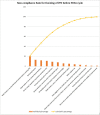Compliance to donning and doffing of personal protective equipment among dental healthcare practitioners during the coronavirus pandemic: a quality improvement plan, do, study and act (PDSA) Initiative
- PMID: 36171006
- PMCID: PMC9527742
- DOI: 10.1136/bmjoq-2022-002001
Compliance to donning and doffing of personal protective equipment among dental healthcare practitioners during the coronavirus pandemic: a quality improvement plan, do, study and act (PDSA) Initiative
Abstract
Introduction: With the emergence of SARS-Cov-2, the Centers for Disease Control and Prevention (CDC) defined mandatory guidelines for donning and doffing personal protective equipment (PPE) among dental healthcare professionals. The study's objective was to improve the compliance of the donning and doffing protocols for PPE among dental practitioners by the Plan, Do, Study, and Act (PDSA) cycle.
Materials and methods: A quasi-experimental study was conducted on a sample of dental healthcare professionals using the non-probability purposive technique. In the first planning stage, compliance with CDC-approved donning and doffing was assessed on the clinical premises. In the second stage, an educational session was arranged with all the healthcare professionals to explain stepwise guidelines of donning and doffing to improve the quality of donning and doffing compliance. In the third stage, improvement in the quality outcome was then assessed after the session. Data were normally distributed. Qualitative variables for all the steps of donning and doffing are reported as frequency and percentages. Pareto charts were made to assess the non-compliance rate for donning and doffing protocols among dental healthcare professionals.
Results: There was an improvement of 44.55% in the hand hygiene practices before wearing the PPE after the second step of the PDSA cycle. A percentage improvement of 7.4% was recorded for removing jewellery, wearing the gown and wearing a surgical cap. No improvement was seen in securing the mask/ respirator ties, washing hands after wearing the respirator, placing the goggles or face shield practices.
Conclusions: PDSA cycle improved the overall compliance to PPE donning and doffing practices. Most of the protocols were followed by the dental healthcare professionals; however, some of them remained the same or worsened due to ease in SARS-CoV 2 restrictions.
Keywords: COVID-19; Continuous quality improvement; Quality improvement.
© Author(s) (or their employer(s)) 2022. Re-use permitted under CC BY-NC. No commercial re-use. See rights and permissions. Published by BMJ.
Conflict of interest statement
Competing interests: None declared.
Figures





Similar articles
-
Personal protective equipment for preventing highly infectious diseases due to exposure to contaminated body fluids in healthcare staff.Cochrane Database Syst Rev. 2020 May 15;5(5):CD011621. doi: 10.1002/14651858.CD011621.pub5. Cochrane Database Syst Rev. 2020. PMID: 32412096 Free PMC article.
-
Personal protective equipment for preventing highly infectious diseases due to exposure to contaminated body fluids in healthcare staff.Cochrane Database Syst Rev. 2020 Apr 15;4(4):CD011621. doi: 10.1002/14651858.CD011621.pub4. Cochrane Database Syst Rev. 2020. Update in: Cochrane Database Syst Rev. 2020 May 15;5:CD011621. doi: 10.1002/14651858.CD011621.pub5. PMID: 32293717 Free PMC article. Updated.
-
How to rapidly design and operationalise PPE donning and doffing areas for a COVID-19 care facility: quality improvement initiative.BMJ Open Qual. 2020 Sep;9(3):e001022. doi: 10.1136/bmjoq-2020-001022. BMJ Open Qual. 2020. PMID: 32978176 Free PMC article.
-
Assessment of dental health care personnel protocol deviations and self-contamination during personal protective equipment donning and doffing.J Am Dent Assoc. 2022 Nov;153(11):1070-1077.e1. doi: 10.1016/j.adaj.2022.08.004. Epub 2022 Sep 26. J Am Dent Assoc. 2022. PMID: 36175202 Free PMC article.
-
Personal protective equipment for preventing highly infectious diseases due to exposure to contaminated body fluids in healthcare staff.Cochrane Database Syst Rev. 2019 Jul 1;7(7):CD011621. doi: 10.1002/14651858.CD011621.pub3. Cochrane Database Syst Rev. 2019. Update in: Cochrane Database Syst Rev. 2020 Apr 15;4:CD011621. doi: 10.1002/14651858.CD011621.pub4. PMID: 31259389 Free PMC article. Updated.
Cited by
-
Practice and associated factors of Covid-19 prevention among health professionals in Ethiopia: a systematic review and meta-analysis.Sci Rep. 2025 May 27;15(1):18462. doi: 10.1038/s41598-025-01919-x. Sci Rep. 2025. PMID: 40425603 Free PMC article.
References
MeSH terms
LinkOut - more resources
Full Text Sources
Medical
Miscellaneous
